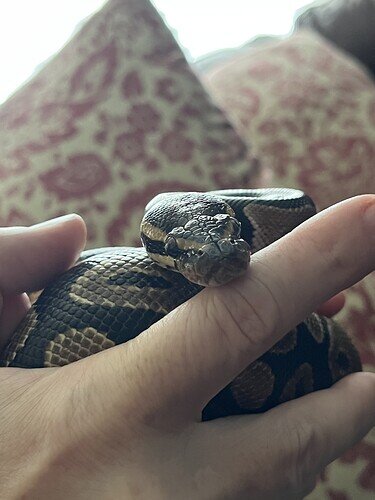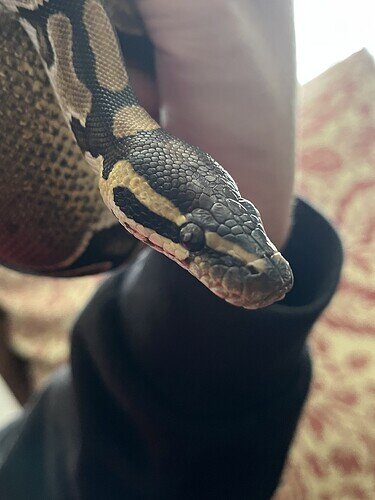My ball python has these white spots on his eyes and I am unsure as to what they are. They look like they are on the tops of his eye, almost like stuck shed?
Its hard tontell from that angle but it looks like stuck eye caps. Some lighter pictures of each eye will help.
It does look like damaged eyecaps. Not the actual eye itself, but if that doesn’t change, it can become worse.
If this animal was coming out of blue and getting ready to shed, they may have been rubbing and the skin is hopefully going to lift soon. But the dry appearance on top of the head as well looks like there may be a lack of the humidity needed.
The only other concern I would have is possibly an early burn causing the dried out look instead of the shedding process. Do a good check of heat sources just in case.
A bit of a soak should help. Also a good mist of the enclosure for the extra humidity. Monitor the snake for shedding.
If the eye appears worse or the snake hurts itself more while shedding you would need to find a qualified vet.
It does look very much like your guy has issues with this eye caps. I definitely agree with everything stated. How long has it been since he shed? If he’s shed recently, I would put together a moist hide container of sorts (of course with air holes) with damp moss or coco coir, or even damp paper towels. Leave him in that for a couple of hours and see if he’s gotten the stuck bits off for himself. If that doesn’t work, and it’s been more than a few days since he shed, a vet visit is in order.
Good luck!
He shed a couple months ago, February I think, but I didn’t notice the spots on him till recently. I haven’t been good at keeping his humidity up because it is extremely hard (any tips to keep humidity up?). He didn’t eat last weekend so I am trying to increase humidity to see if he will eat as well as to fix his eyes.
What sort of enclosure do you have? Covering up some of the ventilation would help, with something like tape (for ventilation holes/slots) or plastic wrap (for a screen). Don’t totally cover up all ventilation, he still needs fresh air, but covering up some of it will help keep humidity.
You can also try adding a water bowl with a larger surface area. That will promote more evaporation, which will raise the ambient humidity.
You can get a humidifier and put it near his enclosure. You can also mist more often, and when you do mist, soak everything more thoroughly.
You’ll have to play around with things a bit to figure out what works best in your home climate. It’s pretty dry in my house in the winter, so I do a combination of covering up some of her top ventilation and misting more often (and when I mist, I REALLY try to soak everything down). Normally I can get away with misting once a day, but sometimes I have to do it twice a day (morning and evening). I have a different species of python, but her humidity needs are only slightly higher than a ball python.
He has a thrive 40 gallon enclosure, I know that glass enclosures don’t hold humidity well but it’s all I have
cover 1/2 to 3/4 of the screen top with foil or if you care a lot about how it looks you can cut some plexiglass down to size. also a deep layer of cypress mulch or Eco earth will help keep humidity up. That should help keep the humidity up and you won’t have to worry about stuck shed
I’ve one tip, in addition to the excellent tips given. You can put a water dish over/very near the heat source to help boost humidity.
Then I’d recommend using foil or plastic wrap to cover up part of the screen. I’d probably start with covering half the screen and see where that gets you with humidity, then cover more if necessary.
You might also consider using a different type of enclosure. It doesn’t need to be anything fancy or expensive. A plastic storage tote of appropriate size with a latching lid would work great. You can easily add ventilation with a drill or soldering iron. Plastic tubs retain heat and humidity better than glass tanks. Only downside is that it won’t look as nice as a glass tank or purpose-built PVC enclosure.
I don’t think there’s necessarily anything wrong with the glass tank so long as you’re able to maintain proper environmental conditions, but if maintaining those conditions continues to be a challenge, it’s good to remember that there are inexpensive alternatives that could make your job a little easier.
This suggestion right here is the one if you’re having long term issues. I swear by keeping my animals in bins (though I do work with colubrids and not BPs) because overall they’re easier to clean, move, and as mentioned, the heat/humidity retention is great. My animals in glass enclosures end up needing humid hides to shed properly, whereas my bin animals have never had a single issue with shedding.
I personally use humid hides with damp sphagnum moss. My 700, 400 and 300 (approximate guesses) gram ballps fit perfectly in takeout containers ![]()
I just soldered a hole in the top for them to get in, and fill it about 1/4-1/2 full. Pretty much solved the problem for me. They also have dishes big enough to soak in, but mine don’t use them for anything but drinking, and, on occasion, pooping…
I have a humidity hide for my ball python but he never goes in it. I will put him in it and he will just immediately leave

